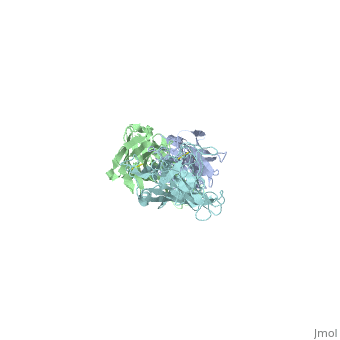User:Marvin O'Neal/Antibody OspA and OspB
From Proteopedia
Contents |
Introduction
A causative agent of lyme disease is Borrelia burgdorferi, a gram negative, helically coiled bacteria that belongs to spirochete phylum. Antibody (blue link and a picture) play a versatile and important role in fighting the Borrelia. The borrelia develops resistance to certain forms of complement-dependent killing, by the evasion of the alternative complement pathway and blocking C3. (La Rocca and Benach 2008) important diverse role of antibody. This increases the importance of the Complement independent killing in fighting the Borrelia burgdorferi. Certain Fragment Antigen Binding fragments of antibody are bactericidal even in the absence of a complement. The binding of specific fabs of IgG and IgM monoclonal antibodies to OspA and OspB of the borrelia leads to a complement-independent lysis of the bacteria (Connolly and Benach 2005).
Fragment Antigen Binding (fab) Reigon
IgG antibody fabs CB2 and H6831(green link), which are structurally similar, target the C-terminal of OspB (green link). H6831 consists of a heavy (green link) and a light (green link) chain and each chain is composed of a variable and a constant domain. The paratope (binding site to the antigen) is located in the N terminal of the variable region of both the heavy and the light chains (Putnam 1979).
OspB and H6831
Interaction between OspB and H6831
Complex interaction between OspB and H6831(Green link) Most hydrogen bonds and electrostatic interactions that are responsible for the binding of H6831 to OspB are between the three adjacent surface-exposed loops (Green link) at the C-terminal of OspB and some residues on the fab heavy chain (Green link) that include tyrosine, tryptophan, glutamate, and histidine. The majority of the electrostatic and hydrogen-bonded interactions are between loop 2 (residues 250-254) and the fab heavy chain. Lysine 253 (green link) in loop 2 of OspB has a necessary and major role due to its central position in the exposed loops. A mutation at its position abrogates the binding interaction and causes the resistance of the bacteria to the bactericidal effect of the fab. Lys 253 binds to the two aromatic residues on the fab heavy chain, tyrosine (green link) and tryptophan (green link). It also makes hydrogen bonds with the glutamate (green link) in the heavy chain of the fab. Carbonyl in loop 1 (green link) of the OspB interacts with histidine in the fab heavy chain. Loop 3 (green link) of OspB interacts with fab light chain. (Becker; Bunikis et al. 2004).
Conformational Changes to OspB
The binding leads to some conformational changes in OspB. Whereas Ding et al. found no changes in the C-terminal of OspA upon the binding to the fab. The most significant difference between the free and the complexed structure of OspB is the loss of the central beta sheet strands 1-4. Both small positional shifts near the Fab binding site and a few larger structural changes away from the binding site were observed. The largest shifts (7– 8 Å) correspond to the repositioning of a loop opposite the Fab-binding site (residues 218 –220). In the free OspB structure, all regions that exhibit shifts are adjacent to the central sheet; in the OspB-H6831 complex they all shift toward, and slightly overlap, the position of the missing sheet. These observations suggest that the larger conformational changes are related to the loss of the central sheet, which could have happened through proteolytic cleavage or fortuitous crystal contacts (Becker; Bunikis et al. 2004)
Requirements for the bactericidal effect and proposed mechanism
The fab binding destabilizes the outer membrane (OM) of B. burdorferi, with subsequent formation of spheroplasts. It has been observed that the bactericidal action, but not the binding, requires the presence of bivalent cations (Mg2+ and Ca2+). Escudero et al. study demonstrated the inability of fab to kill bacteria in the absence of the bivalent cations. It was speculated that OspB- Cb2 (a fab similar to H6831) complexes could create physical openings in the OM allowing for rapid infusion of electrolytes, increasing the osmolarity of the periplasm and triggering bivalent cation dependent cascades (Escudero; Halluska et al. 1997). Need to be rephrased and squeezed and may be a sentence about the cholestrol needs to be added and if there is a specific function for the charge triad it may be added
OspA and LA-2
|
IgG antibody fabs CB2 and are structurally similar and both target the C-terminal of . H6831 consists of a and a chain and each chain is composed of a variable and a constant domain. The paratope is located at the N terminal of the variable region of both the heavy and the light chains (Putnam 1979). Fab binding destabilizes the outer membrane (OM) of B. burdorferi with subsequent formation of spheroplasts. It has been observed that the bactericidal action upon binding requires the presence of bivalent cations (Mg2+ and Ca2+). When a similar fab, CB2, is bound to OspB, channels open in the OM allowing rapid infusion of electrolytes,increasing the osmolarity of the periplasm and triggering bivalent cation dependent cascades [1]
- When bound to a similar fab CB2, OspB-CB2 complexes could create physical openings in the OM allowing for rapid infusion of electrolytes, increasing the osmolarity of the periplasm and triggering bivalent cation dependent cascades (Escudero; Halluska et al. 1997)##
|
Proteopedia Page Contributors and Editors (what is this?)
Christopher Smilios, Philip J. Pipitone, Safa Abdelhakim, Alexandros Konstantinidis, Jaime Prilusky

